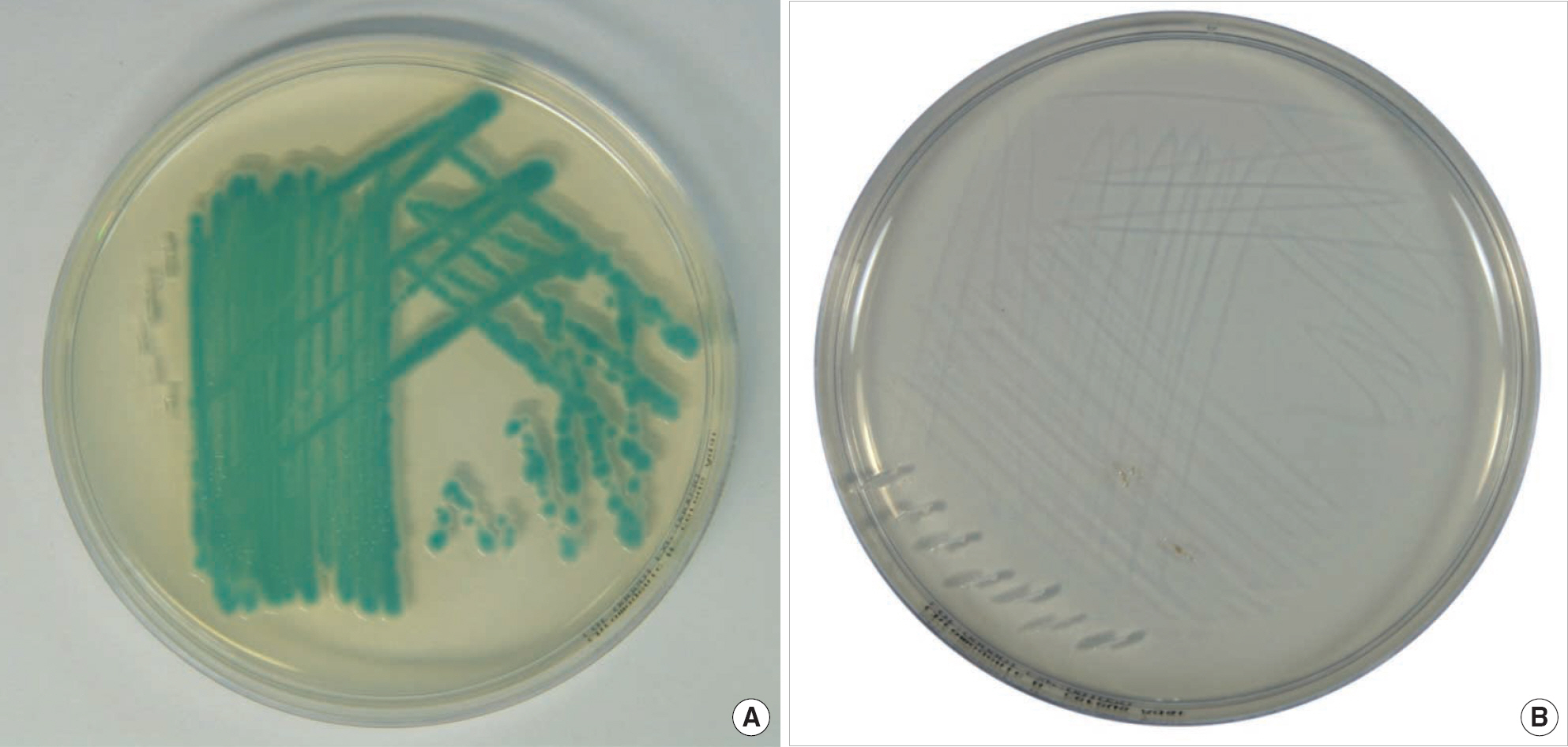Korean J Lab Med.
2010 Aug;30(4):394-399. 10.3343/kjlm.2010.30.4.394.
Usefulness of a Chromogenic Selective Agar for the Identification of Bacillus cereus Isolated from Blood Cultures
- Affiliations
-
- 1Department of Laboratory Medicine, Chonnam National University Medical School, Gwangju, Korea. shinjh@chonnam.ac.kr
- KMID: 1781646
- DOI: http://doi.org/10.3343/kjlm.2010.30.4.394
Abstract
- BACKGROUND
The incidence of Bacillus cereus bacteremia is increasing, but the identification of Bacillus species remains difficult. Brilliance Bacillus cereus agar (BBC agar; Oxoid, UK) is a new CHROMagar medium that allows selective isolation and identification of B. cereus; however, its clinical usefulness is seldom studied. We evaluated the usefulness of BBC agar to identify B. cereus isolates recovered from blood cultures.
METHODS
We analyzed a total of 53 blood isolates that showed a Bacillus-like morphology on Gram staining. All isolates were identified by using both the API Coryne (bioMerieux, France) and API 50CH/B (bioMerieux) systems. They were subsequently subcultured on BBC agar, incubated for 24 hr, and then examined for characteristic blue-green colonies. The clinical characteristics of patients whose isolates were identified as B. cereus were assessed.
RESULTS
Of the 53 isolates, 18 were identified as B. cereus by API 50CH/B. With the API 50CH/B system used as gold standard, the sensitivity and specificity for the identification of B. cereus were 100% (18/18) and 100% (35/35), respectively, using BBC agar, and 67% (12/18) and 100% (35/35), respectively, using the API Coryne system. Of the 18 patients with B. cereus bacteremia, 15 showed infectious signs, and 3 had more than 2 blood cultures positive for B. cereus on separate days.
CONCLUSIONS
Our study shows, for the first time, that BBC agar, with its good agreement and ease of use, is a valuable alternative to the API 50CH/B system for the presumptive identification of B. cereus isolates from blood cultures.
MeSH Terms
-
Adolescent
Adult
Agar/chemistry
Aged
Bacillus cereus/*isolation & purification
Bacteremia/*diagnosis/microbiology
Child
Child, Preschool
Chromogenic Compounds/*chemistry
Culture Media
Female
Gram-Positive Bacterial Infections/*diagnosis/microbiology
Humans
Infant
Infant, Newborn
Male
Middle Aged
Reagent Kits, Diagnostic
Sensitivity and Specificity
Figure
Reference
-
1.Logan NA., Popovic T., Hoffmaster A. Bacillus and other aerobic endospore-forming bacteria. Murray PR, Baron EJ, editors. Manual of clinical microbiology. 9th ed.Washington, DC: American Society for Microbiology;2007. p. 455–73.2.Miller JM., Hair JG., Hebert M., Hebert L., Roberts FJ Jr., Weyant RS. Fulminating bacteremia and pneumonia due to Bacillus cereus. J Clin Microbiol. 1997. 35:504–7.3.Hilliard NJ., Schelonka RL., Waites KB. Bacillus cereus bacteremia in a preterm neonate. J Clin Microbiol. 2003. 41:3441–4.4.John AB., Razak EA., Razak EE., Al-Naqeeb N., Dhar R. Intractable Bacillus cereus bacteremia in a preterm neonate. J Trop Pediatr. 2007. 53:131–2.5.Gaur AH., Shenep JL. The expanding spectrum of disease caused by Bacillus cereus. Pediatr Infect Dis J. 2001. 20:533–4.6.Gaur AH., Patrick CC., McCullers JA., Flynn PM., Pearson TA., Razzouk BI, et al. Bacillus cereus bacteremia and meningitis in immuno-compromised children. Clin Infect Dis. 2001. 32:1456–62.7.Fricker M., Reissbrodt R., Ehling-Schulz M. Evaluation of standard and new chromogenic selective plating media for isolation and identification of Bacillus cereus. Int J Food Microbiol. 2008. 121:27–34.8.Logan NA., Berkeley RC. Identification of Bacillus strains using the API system. J Gen Microbiol. 1984. 130:1871–82.9.Lee CC., Lin WJ., Shih HI., Wu CJ., Chen PL., Lee HC, et al. Clinical significance of potential contaminants in blood cultures among patients in a medical center. J Microbiol Immunol Infect. 2007. 40:438–44.10.Hernaiz C., Picardo A., Alos JI., Gomez-Garces JL. Nosocomial bacteremia and catheter infection by Bacillus cereus in an immunocompetent patient. Clin Microbiol Infect. 2003. 9:973–5.11.Lee YL., Shih SD., Weng YJ., Chen C., Liu CE. Fatal spontaneous bacterial peritonitis and necrotizing fasciitis with bacteraemia caused by Bacillus cereus in a patient with cirrhosis. J Med Microbiol. 2010. 59:242–4.12.Weber DJ., Saviteer SM., Rutala WA., Thomann CA. Clinical significance of Bacillus species isolated from blood cultures. South Med J. 1989. 82:705–9.13.Weber DJ., Saviteer SM., Rutala WA., Thomann CA. In vitro susceptibility of Bacillus spp. to selected antimicrobial agents. Antimicrob Agents Chemother. 1988. 32:642–5.
- Full Text Links
- Actions
-
Cited
- CITED
-
- Close
- Share
- Similar articles
-
- Usefulness of Bacteriological Tests and sspE PCR for Identification of Bacillus cereus Group
- Evaluation of a New Chromogenic agar, CHROMagar Orientation, for Detection and Presumptive Identification of Urinary Tract Pathogens
- Late Prosthetic Joint Infection and Bacteremia by Bacillus cereus Confirmed by 16S rRNA Sequencing and Hip Joint Tissue Pathology
- Distributions of Bacillus cereus, Pseudomonas, Enterococcus, and coliforms Isolated from Agricultural Products
- Molecular Evolution and Identification of Bacillus anthracis Isolated from Korea by Variable Number Tandem Repeat Analysis


